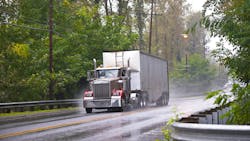While there were more large truck crashes, fewer people were killed in them, according to the latest fatalities and injuries report by the National Highway Traffic Safety Administration. The federal highway safety agency’s statistics lag a year, so its annual update on highway fatalities and injuries compares results from 2022 to 2021.
The definite good news: 716 fewer people were killed in all types of motor vehicle traffic crashes during 2022 than in 2021, a 1.7% decrease. The somewhat good news: for crashes involving large trucks (by NHTSA definition, any commercial or noncommercial vehicle more than 10,000 lb. GVWR), the annual increase in fatalities slowed to 2.0% from 2021 to 2022.
But slow growth is still growth. And no one wants growth of this kind: In 2022, NHTSA estimates that 5,936 people died as a result of truck-involved crashes, while another 160,608 people suffered injuries.
Some might rush to say that truck drivers were not at fault in most of those crashes. Probably true. NHTSA, however, does not attribute fault; NHTSA only reports involvement. Crash involvement can still be catastrophic. In 2022, 1,097 large truck occupants were killed, and 41,874 were injured. Those large truck occupants could have been your drivers and co-workers.
See also: Distracted driving trends up despite awareness
So, how do you keep your trucks and drivers from being involved in a crash? NHTSA actively monitors three driver behavior factors: speeding, alcohol impairment, and failure to use seat belts. You probably already tell your drivers to buckle up, don’t drink and drive (and stay away from those CBD gummies as no government agency certifies their THC content), and don’t speed. Good. But we can all do more on the speeding front.
Legally, we should all stay within the posted speed limit. However, due to traffic, weather, or road conditions, safety may require a slower speed. That means telling our truck drivers to remain continually aware of their surroundings so they have time to adjust their speed and avoid involvement in potentially unsafe situations on the road.
Truck drivers who stay aware of traffic and adjust their speed will probably avoid appearing on next year’s NHTSA report.
About the Author
Steve Vaughn
Senior Vice President of Field Operations
Steve Vaughn is senior vice president of field operations at PrePass Safety Alliance, the provider of PrePass weigh station bypass and electronic toll-payment and management services. Vaughn served nearly three decades with the California Highway Patrol and is a past president of the Commercial Vehicle Safety Alliance.
